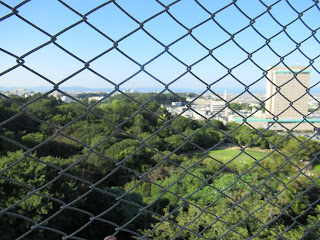Last spring, I came to the premises of the castle, because it is a popular spot for cherry blossom viewing. Near the statue of Tokugawa Ieyasu, there were many people eating and drinking. The statue looks young as Ieyasu lived in Hamamatsu from the age of 29 to 45.
The original castle was destroyed after the Meiji Restoration. The donjon was rebuilt with reinforced concrete in 1958, however, the stone foundations have been there for over 400 years. The stones seem to be roughly put, but they are rigidly constructed. This technique to build a stone foundation is called nozurazumi. Near the stone foundations, there were notice boards that prohibit visitors from climbing up the stone foundations or drawing out stones. But some visitors were laughing and saying that it was impossible to draw them out.
This is the castle gate rebuilt in 2014. Over the doors, there is a turret to store weapons and food and to shoot at enemies with bows or guns.
Today, I entered the castle for the first time since 2006 when my friends living in the metropolitan area came to see me. I expected to see something new. The first thing I noticed was that there were more souvenirs sold near the ticket booth, and there were more visitors than I expected.
As many other castles in Japan, the objects exhibited are mostly war-related things. This is a replica of the armor Tokugawa Ieyasu wore in the Battle in Sekigahara (1600).
In fact, I hadn’t thought that exhibition in this castle was very appealing because many of such historical objects are replica. But this time, I could find something unexpected. A 3D portrait of young Tokugawa Ieyasu! It was well made, and his expression was very real.
On the second floor, you can see some real things such as battle surcoats and hat worn by warriors,
There was also a miniature model of the castle town. I could see how my neighborhood looked like more than 400 years ago.
From the third floor, you can see the present downtown. On the east side, you can see the city hall (gray building on the right) and Act Tower beyond it, the highest building in Hamamatsu.
There were some visitors standing near me, who found the headquarters of Yamaha, the musical instrument company, and talked about where it was. I zoomed in with my camera.
When they talked about Yamaha, I remembered Motoshiro Elementary School, the oldest elementary school in Hamamatsu, that existed next to the castle until 2017. It was the school where a medical instrument technician Torakusu Yamaha succeeded in repairing a foreign-made broken reed organ in 1887 (Two years later, he founded the company to manufacture reed organs). Now, the site has no building because Motoshiro Elementary School was integrated with another elementary school and a junior high school and moved to another place.
On the west side, there is a big Japanese garden known as Hamamatsu Castle Park. I think I’ll visit there in late autumn.
When I came down to the first floor, I noticed one more thing to see. It was a well in the basement. According to the explanation, it was intended to be used when the castle was besieged.
For more information on Hamamatsu Castle, search with “entetsuassist hamamatsu castle.” You can find an informative site.


















No comments:
Post a Comment